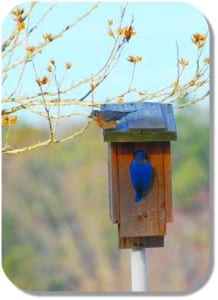By Julia Cencebaugh Kloth for UConn Extension

Beautiful and beneficial the population of the Eastern bluebirds declined in numbers from the late 1800s through the 1980s. One significant contributing factor to this decline was the lack of suitable nesting cavities. Competition for nesting cavities from introduced European starlings and house sparrows, the loss of open field habitats, pesticide use, and severe weather conditions have also played a role in the decline of bluebird populations. Sometimes artificial nesting structures provide more secure nesting places than any other site because artificial nesting can be constructed to resist predators, parasites and destruction of the elements. This is true of bluebird boxes. The bluebird box can be constructed with an entrance hole to exclude starlings and they can be equipped with a special predator guard on a mounting pole.
Bluebirds prefer a semi-open habitat such as orchards, meadows, and other areas with scattered trees and short ground cover. They perch in the open, scanning the ground for their prey of insects and spiders. During fall migration and into winter their diets change to wild fruits and berries such as dogwood and viburnum berries are very important foods along with the fruits of Virginia creeper, eastern red cedar, sumac, bayberry, honeysuckle, winterberry, and many other berry-producing shrubs and vines. These plant species may be used to enhance vegetation that already exists in and along open areas. Adding these species to your currently existing garden will enhance both food and insect availability for these birds. Late spring freezes can endanger Bluebirds and other vulnerable species so stock up on insect feeder foods in early spring so you are prepared if assistance is needed.